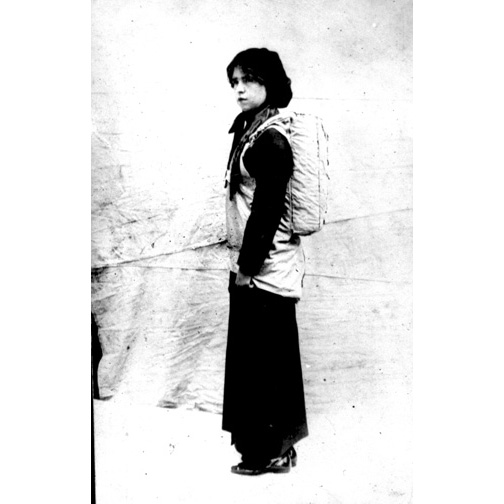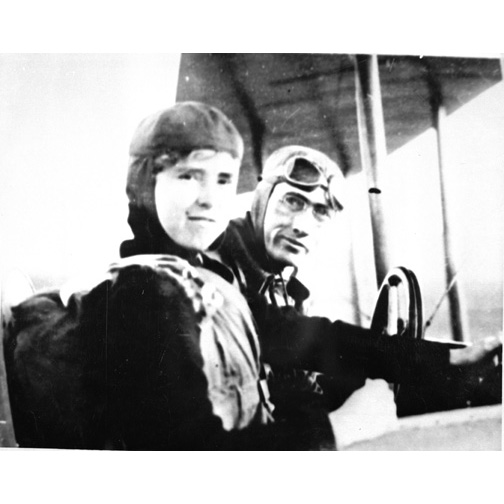Tiny Broadwick
The First Lady of Parachuting
by Elizabeth Whitley Roberson
Reprinted with permission from the Tar Heel Junior Historian. Fall 2003.
Tar Heel Junior Historian Association, NC Museum of History
 North Carolina was the site of the first powered airplane flight in 1903. In 1913, only ten years later, a native North Carolinian became the first woman to make a parachute jump from an airplane.
North Carolina was the site of the first powered airplane flight in 1903. In 1913, only ten years later, a native North Carolinian became the first woman to make a parachute jump from an airplane.
Her birth name was Georgia Ann Thompson. She was born in 1893 on a farm in Granville County, the youngest of the seven daughters of George and Emma Ross Thompson. Because she weighed only three pounds at birth, her family called her Tiny, a name she carried the rest of her life, because even when fully grown, she stood just a few inches over four feet tall and weighed a mere eighty pounds!
Tiny’s family had a difficult time making a living on the farm, and when Tiny was about six years old, her father moved the family to Henderson, where he found work in a local cotton mill. At the time it was not uncommon for women to marry young. Tiny married in 1905, and the next year she gave birth to a daughter. Because of the added expense of caring for a baby, Tiny had to stop going to school and find a job to help support herself and her child. Her husband had abandoned them.
The only job available for her at the time was in the mill where her father worked. Her job involved working twelve- and fourteen-hour shifts, earning forty cents a day. After working those long hours, she had to go home to care for her infant daughter. Gradually, the strain of work and worry about providing for her family took its toll on the frail girl, and she could only hope for some relief and dream of a better life. Unknown to her, that relief would soon come, the day the Jones Carnival arrived in nearby Raleigh.
Tiny had heard her coworkers talking about the State Fair coming to Raleigh and about all the exciting things to see there. She found someone to take her to Raleigh when the fair arrived in 1907, and there she saw the act “The Broadwicks and Their Famous French Aeronauts,” which was part of the Jones Carnival. The act was used to draw crowds into the midway and involved the ascent of a hot-air balloon. The performers went up in the balloon’s basket, then climbed over the side and floated back down to earth. Tiny said about her first reaction to seeing this act, “When I saw that balloon go up, I knew that’s all I ever wanted to do!” After the show was over, she talked to Charles Broadwick, the owner, and asked if she could travel with the group and become a part of the act. Broadwick could see that Tiny, with her beauty and her diminutive size, would be a great drawing card for his show, and he agreed to hire her.
Tiny joined the carinval and left her daughter with Tiny's mother, agreeing to send part of her salary home to support the child. This began a career that led her all over the United States, making her the sweetheart of carnival crowds.
Tiny first jumped in 1908 at the North Carolina State Fair. When asked what her feelings were when she parachuted off the balloon, she said, “I tell you, honey, it was the most wonderful sensation in the world!” She said that from up in the air she could appreciate the beauty of the earth from a new perspective and felt that she was in the presence of God.
Broadwick capitalized on Tiny’s diminutive size, her long brown curls, and her youth by dressing her like a doll and billing her as the Doll Girl. She was outfitted in ruffled bloomers, with pink bows on her arms, ribbons in her long curls, and a little bonnet on her head, all of which made her look like a small child. In later years, Tiny confessed that she was really a tomboy and hated having to dress up like that.
After Tiny joined the group, Broadwick got permission from her father to adopt her legally as his daughter, giving her the name Tiny Broadwick. According to family members, Tiny’s father did not object to the adoption, since the social practices of the time dictated that it was improper for a young girl to travel around the country alone with an older man.
Broadwick began teaching Tiny the craft of parachuting. Her performances drew large crowds, and she became the star attraction of the show. Newspaper accounts described her as the most daring female aeronaut (balloonist) ever seen and marveled at the dangerous maneuvers she performed with apparently little or no fear.
 The Broadwicks traveled all over the country with their balloon act, but by 1912 that type of performance had become outdated. By chance a new challenge confronted them. They went to Los Angeles, California, to participate in an air meet, and there Tiny met a famous pilot named Glenn L. Martin. He had seen her jump from a balloon but wanted her to parachute from his airplane instead. He could see her potential for attracting crowds to watch his airplane act. When he asked Tiny if she would parachute from his plane, without hesitation she said yes. This event marked a whole new chapter in Tiny’s career and ultimately gave her a place in history.
The Broadwicks traveled all over the country with their balloon act, but by 1912 that type of performance had become outdated. By chance a new challenge confronted them. They went to Los Angeles, California, to participate in an air meet, and there Tiny met a famous pilot named Glenn L. Martin. He had seen her jump from a balloon but wanted her to parachute from his airplane instead. He could see her potential for attracting crowds to watch his airplane act. When he asked Tiny if she would parachute from his plane, without hesitation she said yes. This event marked a whole new chapter in Tiny’s career and ultimately gave her a place in history.
She used a parachute developed by Charles Broadwick. It was made of silk and, when packed, looked like a knapsack attached to a snug-fitting canvas jacket with harness straps. A string was fastened to the fuselage (body) of the plane and woven through the parachute’s canvas covering, so that when the wearer jumped from the plane, the cover would be ripped off, leaving the parachute free to fill with air. Tiny was suspended from a trap seat just behind the wing and outside the cockpit, with the parachute on a shelf above her. Martin took the plane up to two thousand feet, and then Tiny released a lever alongside the seat, allowing it to drop out from under her.
After her first jump from Martin’s plane, Tiny was in great demand all over the country. In 1914 she was called upon to demonstrate to government officials the effectiveness of parachutes as an avenue of escape for pilots. Many pilots had perished because they had no way to get out of a falling plane. Tiny made four jumps that day, three of which were successful.
On the fourth jump her parachute’s line became entangled in the tail assembly of the plane. The force of the wind flipped her small body back and forth, and she could not get back into the plane. She didn’t panic, however. Instead, she cut off all but a short length of the line and then pulled it by hand, freeing the lines that opened the parachute. This development was later called a rip cord. By her quick thinking, Tiny became the first person ever to make a planned free-fall descent. Her accident meant that a person leaving a plane would no longer need a line attached to the aircraft to open his or her chute. Tiny demonstrated that day that a pilot could safely bail out of an airplane. The parachute became known as the life preserver of the air.
After more than one thousand jumps, Tiny made her last one in 1922. Her ankles had begun to bother her when she landed. She was very reluctant to give up parachuting because, she said, “I breathe so much better up there, and it’s so peaceful being that near to God.” She spent her last years in California but was buried in Henderson, North Carolina, after she died in 1978 at the age of eighty-five.
In her way, Tiny Broadwick helped give confidence to the thousands of flyers who came after her; they knew that there was a way to escape a failing aircraft. She contributed to the flight history that helped make America the nation that gave wings to the world. Tiny was truly a pioneer and will always be remembered as the First Lady of Parachuting.
At the time of this article’s publication, Elizabeth Whitley Roberson taught at Williamston Middle School in Williamston. She is a former Tar Heel Junior Historian Association adviser and has written the books Weep Not for Me, Dear Mother; In Care of Yellow River, a companion book to Weep Not; and Tiny Broadwick: The First Lady of Parachuting.
Educator Resources:
Tiny Broadwick Pioneer of Aviation Lesson Plan, State Archives of North Carolina
References and additional resources:
"Tiny Broadwick." 2003. Aviation Pioneers. State Archives of North Carolina. http://exhibits.archives.ncdcr.gov/ffc/Flight/Aviation/Tiny_Broadwick.html
Image Credits:
"Tiny Broadwick with parachute." Photo courtesy of the State Archives of North Carolina. Call no. N.69.8.42. http://exhibits.archives.ncdcr.gov/ffc/Flight/Aviation/tinyimage5.html (accessed November 1, 2013).
"Tiny Broadwick with Glenn Martin." Photo courtesy of the State Archives of North Carolina.. Call no. N.61.2.36.
http://exhibits.archives.ncdcr.gov/ffc/Flight/Aviation/tinyImage.html (accessed November 1, 2013).
1 January 2003 | Roberson, Elizabeth Whitley